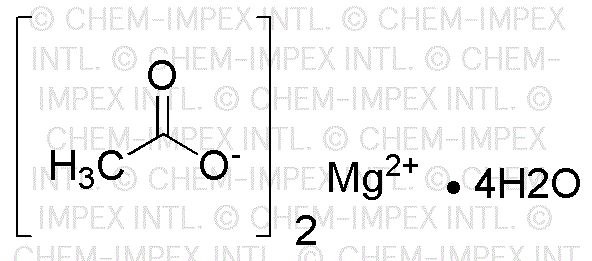Magnesium acetate tetrahydrate is widely utilized in research focused on:
- Pharmaceutical Formulations: It serves as a buffering agent in drug formulations, helping to maintain the pH level, which is crucial for drug stability and efficacy.
- Food Industry: This compound acts as a food additive, enhancing flavor and preserving food quality, making it valuable in processed food production.
- Textile Industry: Used in dyeing processes, it improves the uptake of dyes on fabrics, leading to brighter and more durable colors.
- Cosmetics: In personal care products, it functions as a humectant, helping to retain moisture in skin and hair formulations.
- Laboratory Reagent: It is commonly employed in biochemical research as a reagent for various assays, providing reliable results in experiments.
General Information
Properties
Safety and Regulations
Applications
Magnesium acetate tetrahydrate is widely utilized in research focused on:
- Pharmaceutical Formulations: It serves as a buffering agent in drug formulations, helping to maintain the pH level, which is crucial for drug stability and efficacy.
- Food Industry: This compound acts as a food additive, enhancing flavor and preserving food quality, making it valuable in processed food production.
- Textile Industry: Used in dyeing processes, it improves the uptake of dyes on fabrics, leading to brighter and more durable colors.
- Cosmetics: In personal care products, it functions as a humectant, helping to retain moisture in skin and hair formulations.
- Laboratory Reagent: It is commonly employed in biochemical research as a reagent for various assays, providing reliable results in experiments.
Documents
Safety Data Sheets (SDS)
The SDS provides comprehensive safety information on handling, storage, and disposal of the product.
Product Specification (PS)
The PS provides a comprehensive breakdown of the product’s properties, including chemical composition, physical state, purity, and storage requirements. It also details acceptable quality ranges and the product's intended applications.
Certificates of Analysis (COA)
Search for Certificates of Analysis (COA) by entering the products Lot Number. Lot and Batch Numbers can be found on a product’s label following the words ‘Lot’ or ‘Batch’.
*Catalog Number
*Lot Number
Certificates Of Origin (COO)
This COO confirms the country where the product was manufactured, and also details the materials and components used in it and whether it is derived from natural, synthetic, or other specific sources. This certificate may be required for customs, trade, and regulatory compliance.
*Catalog Number
*Lot Number
Safety Data Sheets (SDS)
The SDS provides comprehensive safety information on handling, storage, and disposal of the product.
DownloadProduct Specification (PS)
The PS provides a comprehensive breakdown of the product’s properties, including chemical composition, physical state, purity, and storage requirements. It also details acceptable quality ranges and the product's intended applications.
DownloadCertificates of Analysis (COA)
Search for Certificates of Analysis (COA) by entering the products Lot Number. Lot and Batch Numbers can be found on a product’s label following the words ‘Lot’ or ‘Batch’.
*Catalog Number
*Lot Number
Certificates Of Origin (COO)
This COO confirms the country where the product was manufactured, and also details the materials and components used in it and whether it is derived from natural, synthetic, or other specific sources. This certificate may be required for customs, trade, and regulatory compliance.

